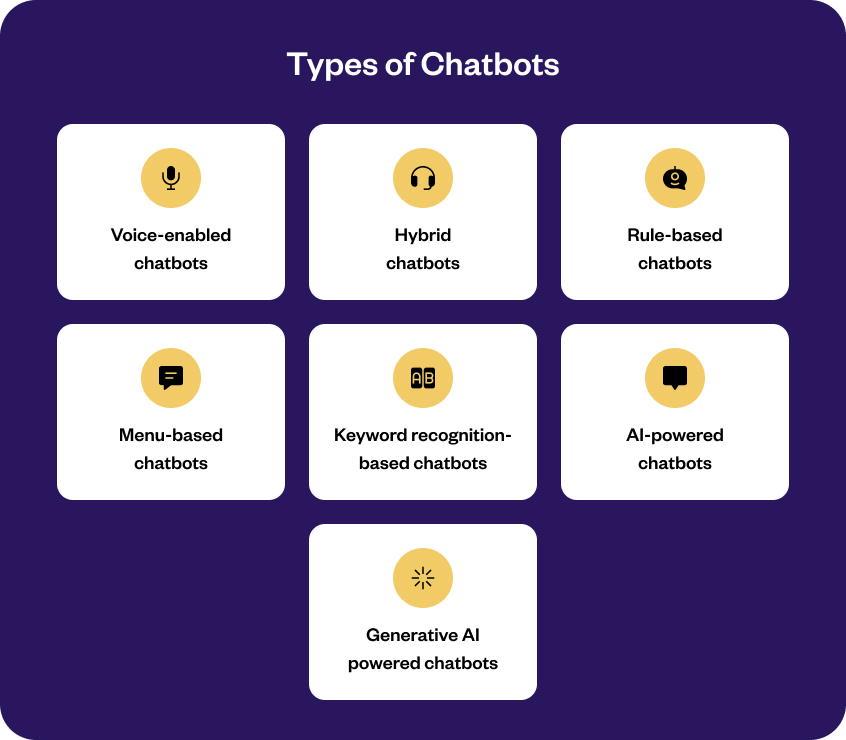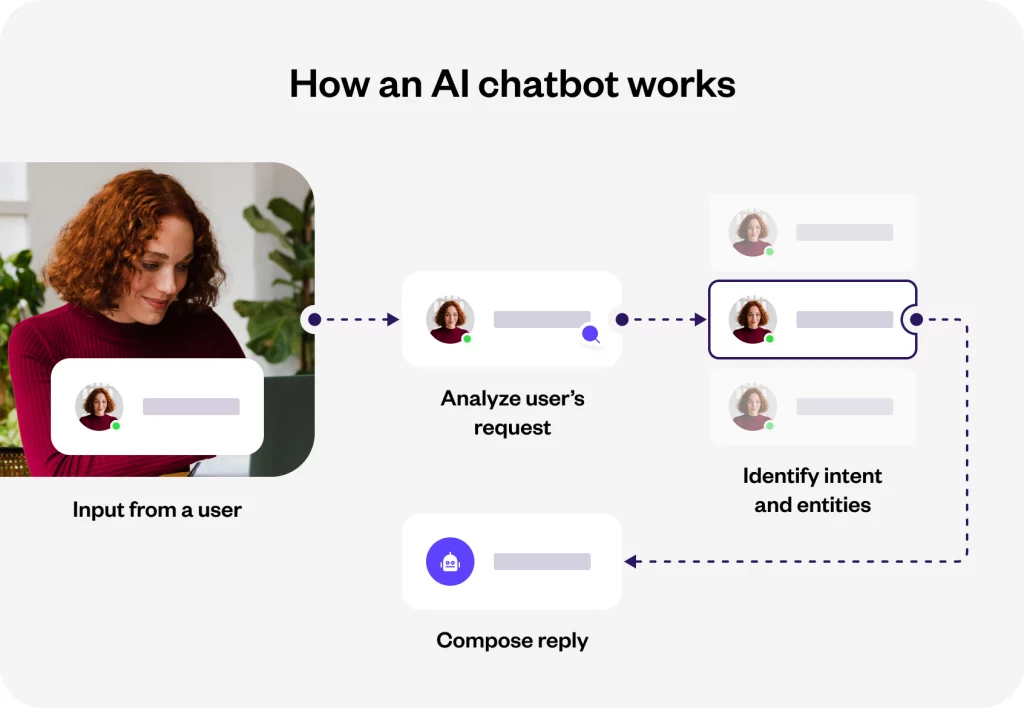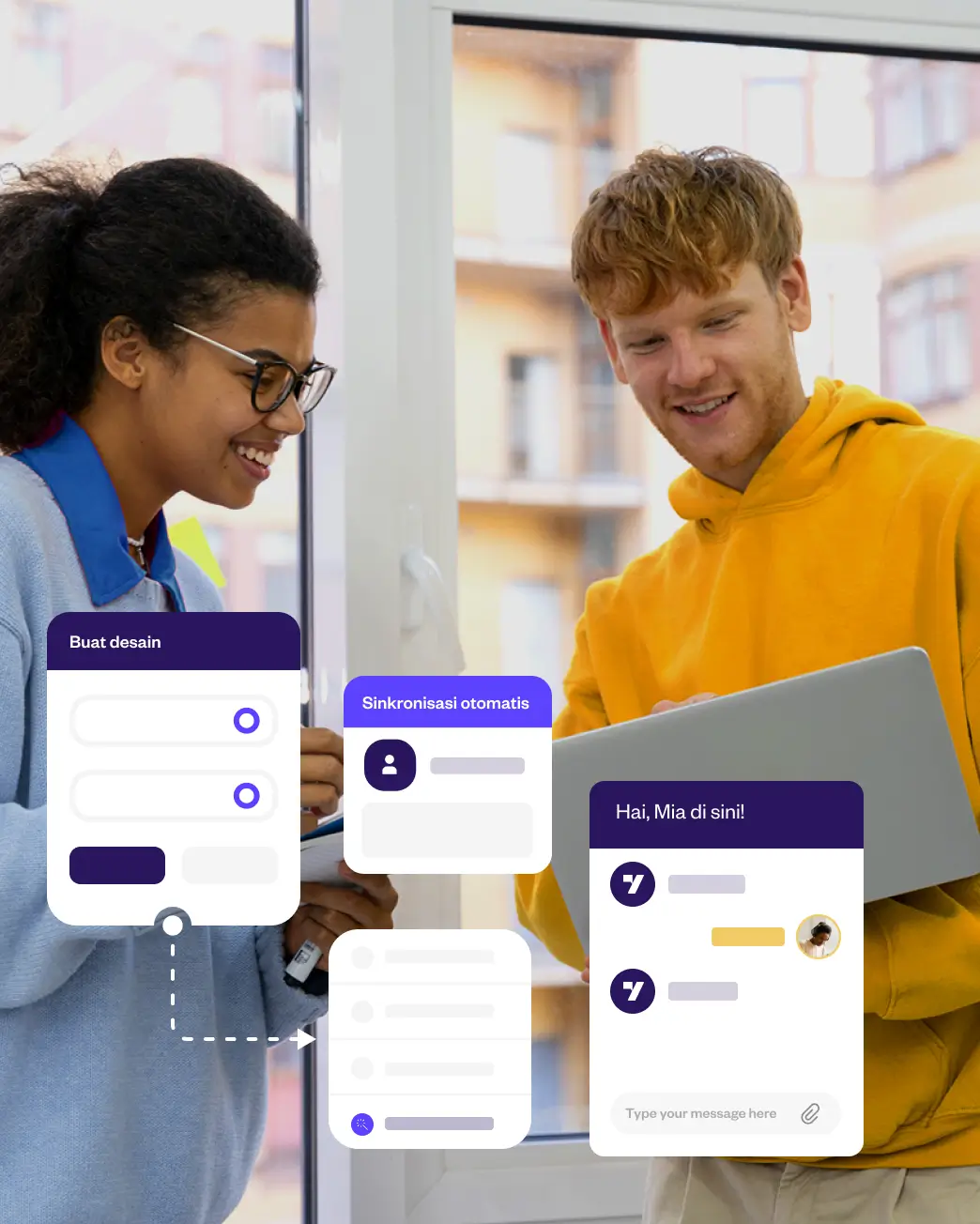Executive summary
In 2024, AI chatbots will stand at the forefront of technological innovation in business communication. This article delves into the realm of AI chatbots, exploring their definition, types, and the various ways they enhance customer engagement and operational efficiency. Focusing on the latest advancements and the best AI chatbots of the year, we provide a detailed overview of how these digital assistants are transforming the customer journey map and managing workflows, all while highlighting key players like Yellow.ai in simplifying AI chatbot creation.
The year 2024 marks a turning point in how businesses interact and connect. At the heart of this transformation are AI chatbots, transcending traditional text-based dialogues to deliver rich, context-sensitive, and personalized user experiences. Their widespread adoption across diverse industries signifies a significant shift in customer relations and operational methodologies. The chatbot market, mirroring this trend, is expected to see explosive growth, with projections indicating a 22.5% increase from 2020 to 2027, reaching an astounding $1,953.3 million in value. Such growth underscores the chatbots’ vital role across various industries, signifying a significant shift in customer relations and operational methodologies.
Imagine a journey from humble digital beginnings to sophisticated, multi-faceted tools that not only respond to queries but also predict needs, analyze complex data, and even influence decision-making. This is the story of AI chatbots, driven by leaps in AI, natural language processing, and machine learning. These advancements have endowed chatbots with an ability to learn and evolve from each interaction, ensuring they not only converse but connect on a more human level.
As we go deeper into the world of AI chatbots in 2024, we’ll explore how they are revolutionizing the way businesses engage with their customers and optimize their internal processes. The impact of AI chatbots is far-reaching, setting new benchmarks in efficiency and transforming the customer journey into an immersive, interactive experience.
Related must-reads:
What is an AI chatbot?
In digital communication, AI chatbots are the game-changers for businesses in 2024. An AI chatbot is a sophisticated blend of technologies that simulates human-like conversation through text or speech interfaces. These aren’t your average chatbots that simply follow a script; AI chatbots are imbued with artificial intelligence, machine learning (ML), and natural language processing (NLP). They have the extraordinary ability to understand, interpret, and respond to user queries in a manner that mirrors human interaction.
For businesses, this translates into a more dynamic way of engaging with customers. Instead of offering generic replies, AI chatbots can navigate complex conversations, making customers feel heard and understood. They are a practical solution for today’s businesses, helping to streamline customer interactions, gather insights, and improve overall service efficiency. As we move through 2024, these chatbots are becoming indispensable in the toolkit of modern businesses, reshaping the landscape of digital customer service.
Types of chatbots
The world of chatbots presents a diverse array of options, each designed to cater to specific business needs and customer interaction styles. Understanding these types is crucial for businesses to choose the right type of chatbot that aligns with their objectives and customer engagement strategies. Here’s a rundown of the key types of chatbots available:

Each type of chatbot has its unique strengths and ideal use cases. For businesses in 2024, understanding these types helps in selecting the right chatbot that not only meets their current needs but also aligns with their future growth and customer engagement strategies.
Which is better: Rule-based chatbots or AI chatbots?
Digital communication is ever-evolving, and businesses often grapple with the decision between rule-based and AI chatbots. Each type has its unique strengths and applications, making the choice largely dependent on the specific needs and goals of a business.
Rule-based chatbots operate on predefined rules and logic. They can handle specific, predictable queries where responses can be pre-scripted. The significant advantage of rule-based chatbots lies in their simplicity and reliability. They are easier to set up and control, ensuring consistent responses to common queries. It makes them ideal for businesses looking for a straightforward, cost-effective solution for handling routine customer interactions.
AI chatbots, on the other hand, are powered by artificial intelligence, particularly machine learning and natural language processing. It allows them to understand and interpret a wide range of customer queries, providing more dynamic and contextually relevant responses. AI chatbots excel in handling complex interactions, learning from past conversations, and improving over time. They are well-suited for businesses aiming for a more advanced, interactive customer experience, capable of handling nuanced and varied customer needs.
The choice between rule-based and AI chatbots hinges on the complexity of the interactions a business anticipates with its customers. For straightforward, predictable tasks, rule-based chatbots are efficient and cost-effective. However, for a more engaging, personalized customer experience that evolves with user interactions, AI chatbots are the superior choice.
Comparison: Rule-based chatbots vs. AI chatbots vs Next-gen AI bots
| Comparison | Rule-based chatbots | AI chatbots | Next-gen AI bots |
|---|---|---|---|
| Technology Used | Predefined rules | NLP, ML, AI algorithms | Advanced NLP, LLMs, generative models |
| Learning Capability | No learning | Basic learning based on limited training data sets | Continuous learning, self improvement and adaptation based on large data sets |
| Complexity Handling | Limited complexity | Moderate-to-high complexity | High complexity and open-ended conversations |
| Adaptability | Limited adaptability. Limited to disparate channels. | Can adapt to user inputs across channels. | Highly adaptive to user context across channels |
| Understanding | Keyword-based matching | Improved understanding of user intent | Enhanced contextual understanding |
| Personalization | Limited personalization. | Intermediate level of personalization | Highly personalized responses at scale |
| Advanced Features | None | Multilingual, multimodal interaction | Multilingual, emotional intelligence, creativity |
| Use Cases | Basic FAQs, simple tasks. Not conversational | Conversational. End-to-end customer support, e-commerce, virtual assistants | Advanced customer engagement, dynamic Interactions, creative conversations, end-to-end customer support, e-commerce, virtual assistants |
Businesses must assess their specific requirements, customer interaction complexity, and resource availability to make the right choice between these two powerful digital tools.
Benefits of AI chatbots: Amplifying business potential
AI chatbots have moved past mere efficiency enhancers to pivotal tools in crafting meaningful customer experiences. These advanced digital assistants offer a range of benefits that extend beyond cost savings, tapping into deeper layers of customer engagement and operational effectiveness.
Let’s understand the key benefits of AI chatbots and explore how they are redefining customer interactions.
- 24/7 Customer service availability
- Handling high-volume queries
- Empowering agents with valuable insights
- Seamless integration with business ecosystems
- Personalized customer experiences
- Cost-effective customer engagement
- Proactive customer engagement
1. 24/7 Customer service availability
AI chatbots transcend the boundaries of time, providing round-the-clock service to customers across the globe. This perpetual availability ensures that customer queries are addressed instantly, regardless of the hour, enhancing customer satisfaction and loyalty.
Example: A customer from a different time zone visits your e-commerce website. It’s after-hours for your support team, but the AI chatbot is there, ready to help. The customer has questions about product customization options, which the chatbot addresses effortlessly, even suggesting complementary products. This round-the-clock assistance turns a casual browse into a confirmed purchase, demonstrating the chatbot’s ability to drive conversions outside traditional business hours.
2. Handling high-volume queries
The business environment today is fast-paced, and AI chatbots are adept at managing a high volume of customer interactions simultaneously. This ability significantly reduces wait times and improves overall efficiency, allowing human agents to focus on more complex issues.
Example: During a seasonal sale, your retail website is inundated with inquiries. The AI chatbot efficiently categorizes and responds to these queries, from stock checks to delivery times, preventing the potential loss of sales due to overwhelmed human agents. This scalability ensures a smooth customer experience, even under high demand.
3. Empowering agents with valuable insights
AI chatbots are beyond just conversation handlers; they are insightful data gatherers. By analyzing customer interactions, they provide valuable insights to human agents, enhancing the quality of customer service and aiding in strategic decision-making.
Example: In a scenario where a customer has a complex billing issue, the AI chatbot initially engages and collects preliminary information. Once it identifies the complexity, it seamlessly transfers the query to a human agent, who now has all the necessary information to resolve the issue quickly. This synergy between AI and human intelligence leads to more efficient problem-solving and higher customer satisfaction.
4. Seamless integration with business ecosystems
AI chatbots in 2024 are adept at integrating seamlessly with various business systems like CRM, inventory management, and marketing platforms. This integration streamlines workflows and ensures a cohesive customer journey.
Example: A small business owner wants to deploy an AI chatbot but lacks technical expertise. Using Yellow.ai, they quickly create a chatbot tailored to their business needs, which not only handles customer inquiries but also integrates with their CRM system for seamless data management. This hassle-free deployment with Yellow.ai enables even small businesses to compete in the digital space effectively.
5. Personalized customer experiences
One of the most significant advantages of AI chatbots is their ability to personalize interactions. By analyzing past interactions and customer data, chatbots can tailor conversations, making each interaction unique and relevant to the individual customer.
Example: A returning customer interacts with your AI chatbot, which recognizes their purchase history and preferences. It suggests new products aligned with their taste and even remembers their size preferences, making the shopping experience feel highly personalized and thoughtful. This level of personalization cultivates a sense of brand loyalty and increases the likelihood of repeat purchases.
6. Cost-effective customer engagement
Deploying AI chatbots is a cost-effective solution for businesses. By automating routine interactions, they reduce the need for extensive human customer service teams, leading to significant savings in operational costs.
Example: A first-time visitor on your site is browsing but seems hesitant. The AI chatbot initiates a conversation, offering assistance. Based on the visitor’s browsing behavior, the chatbot suggests a beginner’s guide to your product range and a first-time purchase discount. This proactive engagement converts a hesitant browser into a confident buyer.
7. Proactive customer engagement
AI chatbots in 2024 are not just reactive; they are proactive in engaging customers. They can initiate conversations based on customer behavior or events, enhancing engagement and customer retention.
Example: An AI chatbot, observing a customer’s repeated visits to a product page, initiates a conversation offering detailed information about the product and a special one-time discount, encouraging the customer to make a purchase.
Understanding how AI chatbots work: A deep dive into their mechanics
At their core, AI chatbots are a blend of various technologies, chiefly natural language processing (NLP), machine learning (ML), and often deep learning. These technologies empower chatbots to understand, process, and respond to human language in a way that feels intuitive and contextually relevant.

1. Natural Language Processing (NLP)
This is where the magic starts. NLP allows chatbots to interpret and make sense of human language. It involves breaking down a user’s input into understandable segments, deciphering syntax, and grasping semantics. This process enables the chatbot to comprehend the literal meaning of words and their contextual and colloquial nuances.
Related read: What is Natural Language Processing (NLP)?
Example: Consider a customer asking, “Can you show me eco-friendly options for laptops?” An AI chatbot equipped with NLP understands the request’s context and responds with a curated list of eco-friendly laptops rather than just any laptop or unrelated eco-friendly products.
2. Machine Learning (ML) and Deep Learning (DL)
Machine learning enables chatbots to learn from past interactions and improve over time. Deep learning, a subset of ML, uses neural networks to mimic human brain functions, allowing for even more sophisticated learning and decision-making. It means the more interactions a chatbot has, the better it becomes at predicting and responding to user needs.
Example: An AI chatbot in a customer service role learns from previous queries about common issues and refines its responses. For instance, if it notices a trend in inquiries about a specific product feature, it adapts to provide more detailed information about that feature in future interactions.
3. Integration with databases and systems
Modern AI chatbots are integrated with databases and business systems, allowing them to pull information and perform tasks. This integration can range from accessing a product database for recommendations to interfacing with a CRM system for personalized customer interactions.
Example: A chatbot integrated with a CRM system can recognize a returning customer, access their purchase history, and offer tailored assistance or recommendations based on their past interactions and preferences.
4. Sentiment Analysis
An advanced feature in AI chatbots is sentiment analysis. By analyzing the tone and emotion behind a user’s words, chatbots can tailor their responses to be more empathetic and context-sensitive.
Example: If a chatbot detects frustration in a customer’s query, it might respond with more reassuring language or quickly escalate the issue to a human agent.
5. Predictive analytics and decision-making
AI chatbots can anticipate user needs and offer proactive assistance by leveraging big data and predictive analytics. They can analyze patterns in user behavior and preferences to make informed suggestions or decisions.
Example: A chatbot in an e-commerce setting might analyze a customer’s browsing habits and previous purchases to suggest new products they are likely to be interested in.
6. Human oversight and continuous learning
Despite their advanced AI, chatbots still operate under human oversight. Continuous learning from user interactions and human input keeps them evolving and prevents them from becoming obsolete or inaccurate.
Example: A team regularly reviews chatbot interactions in a customer support setting, providing feedback and updates to the AI model, ensuring the chatbot remains effective and up-to-date with company policies and product information.
AI chatbots represent a harmonious blend of artificial intelligence and human-like empathy, creating interactions that are efficient, personalized, and increasingly sophisticated. Their complexity and adaptability make them invaluable assets in the modern business landscape, revolutionizing how companies interact with their customers and manage their internal processes.
Get the best of Human+AI!

The best AI chatbots in 2024
AI chatbots have become indispensable across various sectors. Besides enhancing user experiences, these advanced tools are also streamlining processes and amplifying business outcomes. Let’s explore the top AI chatbots in 2024, categorized by their primary use cases.
| Use case | Software |
| Content generation and summarization | ChatGPT, Jasper, ChatSonic, Bard, copy.ai, HuggingChat, ZenoChat |
| Customer service and CX | Yellow.ai |
| Browsing the web | Bard, Bing, Perplexity |
| Translations | Bard, ChatGPT |
| Entertainment | MY AI, Character.AI, Replika, Pi |
| Education | Khanmigo, Socratic by Google |
| Mental health | Woebot |
| Research | You.com |
| Conversation | Character.AI, Replika, Claude |
| HR and recruitment | Ideal |
| Coding | ChatGPT, Amazon CodeWhisperer |
| Social media | My AI |
| Data collection, analysis, and visualization | Bing, Rose AI |
| Graphics | Bing, Jasper, Character.AI, ChatSonic |
| Task handling | HuggingChat, Claude |
| Marketing | ChatSpot |
| Sales | Certainly, Claude |
1. Content generation and summarization AI Chatbots
AI chatbots are revolutionizing how we create and summarize text. They assist in generating original content, crafting compelling narratives, and briefly summarizing extensive information.
Open AI (ChatGPT): ChatGPT, leveraging OpenAI’s GPT-3.5 and GPT-4 models, is renowned for its conversational capabilities and context comprehension. It excels in content creation, summarization, and coding, with additional plugin integrations for tasks like reservations and summarizing web content. Businesses, however, should be cautious of its limitations in customer-facing roles and the potential for biases. ChatGPT
Jasper AI: Utilizing GPT-4 and other advanced models, Jasper Chat specializes in AI-driven copywriting. It assists businesses in maintaining brand consistency and streamlining campaign collaboration. Users can prompt the bot for creative outputs, making it an asset for resource-limited teams. Jasper
ChatSonic: ChatSonic, using GPT-3.5 and GPT-4, stands out for its conversational experience enhancement. It is adept at text and speech inputs and excels in digital art creation and content of varying lengths. Its Chrome extension simplifies the writing and research process for users. ChatSonic
Bard: Powered by Google’s LaMDA, Bard excels in content summarization, translations, and coding. It’s designed for general use, excelling in logic-based queries while striving to minimize misinformation. Bard’s capabilities include drafting various content types, summarization, and co-editing. Bard
Copy.ai: This chatbot specializes in blog writing and email marketing. Using the GPT-3 model, Copy.ai is versatile in generating content across a wide range of writing needs, including product descriptions and marketing copy. It supports multiple languages and offers a range of creative templates. Copy.ai
HuggingChat: An open-source offering by HuggingFace, HuggingChat assists in task handling, email writing, and content generation. It’s useful for a variety of tasks, from coding to recipe listing, and can integrate real-time web searches for updated information. HuggingChat
ZenoChat: Focusing on copywriting and brainstorming, ZenoChat uses GPT-4 and Sophos 2 models. It’s designed to offer personalized experiences in content generation, catering to creatives needing assistance with editing and rewriting. ZenoChat’s AI, trained on billions of sentences, aims to create unique content in over 20 languages. ZenoChat
2. Customer service and customer experience (CX)
For enhancing customer service and CX, AI chatbots offer personalized support, handle queries, and improve overall customer satisfaction.
Yellow.ai: Pioneering in the field of customer service and CX, Yellow.ai’s AI chatbots excel in delivering personalized customer experiences. Their advanced technology enables businesses to automate responses to frequent inquiries while maintaining a human-like interaction quality. Yellow.ai’s chatbots are not just conversation handlers but also insightful data analyzers, providing businesses with critical insights to improve their customer service strategies continually.
Get the best of Human+AI!

3. Browsing the web
Navigating the vast web space is made more efficient with AI chatbots. They help users find accurate information quickly and efficiently.
Bard: Google’s Bard, leveraging the LaMDA model, offers a streamlined web browsing experience. It is particularly adept at summarizing content, translating languages, and even assisting with coding queries. Bard’s ability to provide quick and relevant responses makes it a valuable tool for users seeking efficient web navigation. Bard
Bing: Powered by GPT-4, Bing’s AI chatbot offers comprehensive content creation and data analysis capabilities. It’s integrated within the Bing search engine and Microsoft Edge, providing users with AI-powered results and conversational experiences. Although less creative in its conversations, Bing is useful for general planning and response composition, with features like image generation and visual search. Bing
Perplexity AI: Known for its reliable general knowledge responses, Perplexity AI stands out with its citation-backed answers, reducing misinformation risks. Its new features, Visual Perplexity, and Llama Chat, enhance user experience by offering visual responses and coding assistance. Perplexity AI’s Co-pilot feature, powered by GPT-4, helps users get more targeted search results, making it an excellent tool for in-depth web exploration. Perplexity AI
4. Translations AI Chatbots
Breaking language barriers, these chatbots offer real-time, accurate translations, making global communication seamless.
Bard: Bard’s translation capabilities make it an excellent choice for businesses and individuals needing quick, reliable language translation services. Its proficiency in multiple languages streamlines communication across different cultural and linguistic backgrounds. Bard
ChatGPT: ChatGPT’s advanced language models (GPT-3.5 and GPT-4) enable it to provide accurate translations in various languages. It’s handy for businesses looking to communicate with a global audience, offering translations that are not only linguistically accurate but also contextually relevant. ChatGPT
5. Entertainment AI Chatbots
In the world of entertainment, AI chatbots are transforming the way users engage with digital media. These chatbots offer a range of activities, from interactive storytelling to gaming and even personalized content suggestions, providing a unique and engaging experience for each user.
MY AI: Snapchat’s My AI is a customizable chatbot that brings a unique touch to social media entertainment. It allows users to interact with an avatar, offering suggestions on cultural events and news stories and even helping to find new friends on Snapchat. Its ability to respond with image snaps and personalized interactions makes it a standout choice for a fun and engaging experience. My AI
Character.AI: Character.AI specializes in entertainment and conversation, allowing users to interact with a variety of characters from pop culture. Whether it’s getting advice from a virtual coach or chatting with a favorite celebrity, Character.AI’s varied options and conversational AI make it an entertaining and engaging platform for users seeking a unique interactive experience. Character.AI
Replika: Replika offers a blend of companionship and entertainment, allowing users to engage in empathetic conversations and role-playing scenarios. While it’s not a substitute for professional mental health support, Replika provides a compassionate and entertaining interaction, making it a popular choice for users seeking a friendly chat bot experience. Replika
Pi: Pi provides a friendly and empathetic personal AI experience. Its conversational approach, vast knowledge base, and personalized recommendations make it an ideal choice for users looking for an engaging and human-like interaction in the digital entertainment space. Pi
6. Education AI Chatbots
In the education sector, AI chatbots play a crucial role in enhancing the learning experience. They offer tutoring, homework assistance, and interactive learning activities, making education more accessible and engaging for students of all ages.
Khanmigo: Developed by Khan Academy, Khanmigo is designed to assist both teachers and students. It offers valuable insights for lesson planning and helps students understand complex topics through the Socratic method. Its integration with Khan Academy and multilingual support make it an invaluable tool in the educational landscape. Khanmigo
Socratic by Google: Leveraging Google’s advanced search technologies, Socratic is an educational chatbot that helps learners find answers and understand concepts through detailed explanations and instructional videos. Its user-friendly interface and comprehensive approach to learning make it an excellent tool for students seeking academic support. Socratic by Google
7. Mental health AI Chatbots
AI chatbots offer invaluable support by providing therapeutic conversations, stress relief exercises, and access to mental health resources. These chatbots are designed to help users navigate their emotions and promote mental well-being.
WoeBot: WoeBot uses AI and NLP to offer 24/7 mental health support. Trained in clinical approaches like CBT, IPT, and DBT, it helps users develop coping skills and tackle anxiety, depression, and daily stressors. While not a replacement for professional therapy, WoeBot’s empathetic responses and daily check-ins make it a supportive companion for those seeking mental wellness. WoeBot Health
8. Research AI Chatbots
For research purposes, AI chatbots are a game changer. They assist researchers in data collection, providing access to scholarly information and summarizing complex research findings, thereby streamlining the research process.
You.com: As a conversational search engine, You.com assists in research by delivering direct answers to queries. It goes beyond traditional search engines by offering a more interactive and efficient way to access information. Its features, such as integration with various platforms and personalized search experiences, make it an indispensable tool for researchers. You.com
9. Conversation AI Chatbots
Engaging in meaningful conversations, these chatbots offer companionship and stimulating interactions, enhancing social experiences in the digital realm.
Character.AI: This AI platform lets users converse with a wide array of fictional characters and celebrities, making it an entertaining tool for casual chats and creative engagements. Character.AI’s diverse range of characters and its ability to mimic their conversational styles provide a unique and engaging experience. Character.AI
Replika: Known for its compassionate conversational abilities, Replika offers users a chance for deep, empathetic interactions, acting as a virtual friend. Its role-playing capabilities and supportive dialogue make it a popular choice for those seeking meaningful digital companionship. Replika
Claude: Anthropic’s Claude is a constitutional AI that offers helpful, honest, and harmless interactions. It’s designed to provide task assistance and engage users with its unique HHH system architecture, ensuring reliable and user-friendly conversations. Claude
10. HR and recruitment AI Chatbots
Streamlining the recruitment process, these chatbots assist in candidate screening, enhancing employee engagement, and improving the overall efficiency of HR operations.
Ideal: Ideal’s AI-driven chatbot aids recruiters in engaging with candidates, qualifying them efficiently, and supporting talent acquisition efforts. It ensures compliance with global standards like GDPR, making it a secure and effective tool for modern HR departments. Ideal
11. Coding AI Chatbots
Assisting developers in the realm of coding, these chatbots offer innovative solutions, aid in debugging, and enhance productivity in software development.
ChatGPT: OpenAI’s ChatGPT, known for its coding assistance, provides developers with creative coding solutions and helps in debugging complex code, making it a valuable asset in software development. ChatGPT
Amazon CodeWhisperer: Amazon’s AI coding companion, CodeWhisperer, aids developers in building secure applications efficiently. Its ability to provide real-time code suggestions and identify vulnerabilities makes it an indispensable tool for modern programmers. Amazon CodeWhisperer
12. Social media AI Chatbots
Revolutionizing social media interactions, these chatbots automate responses, manage accounts, and provide insightful analysis of user engagement.
My AI: Snapchat’s My AI enhances social media experiences with its ability to recommend stickers, Bitmojis, and local events, making social interactions more engaging and personalized. My AI
13. Data collection, analysis, and visualization AI Chatbots
These chatbots excel in gathering data, offering analytical insights, and visualizing complex datasets, thereby aiding in data-driven decision-making.
Bing: Microsoft’s Bing chatbot offers complex research capabilities and provides conversational replies, making it a valuable tool for data collection and analysis. Bing
Rose AI: Specializing in data cleaning and visualization, Rose AI assists data scientists in finding and visualizing data efficiently, enhancing the data analysis process. Rose AI
14. Graphics AI Chatbots
Aiding in the field of graphic design, these chatbots offer creative suggestions and automate various design tasks, enhancing the creative process.
Bing: Bing’s AI capabilities extend to graphic design, offering creative image generation and visual search functionalities. Bing
Jasper: Jasper’s AI excels in generating high-resolution images and providing contextual answers, making it a go-to tool for graphic designers seeking creative assistance. Jasper
Character.AI: Known for its diverse character feed and conversational AI, Character.AI is also adept at generating rich visual responses, aiding in creative graphic design. Character.AI
ChatSonic: ChatSonic stands out with its AI art and image generation capabilities, providing a range of creative options for designers and artists. ChatSonic
15. Task handling AI Chatbots
For managing everyday tasks, these chatbots assist in scheduling, reminders, and automating routine activities, enhancing personal and professional productivity.
HuggingChat: HuggingChat, with its conversational interface and task assistance features, helps users manage daily tasks efficiently, making it a valuable personal assistant. HuggingChat
Claude: Claude’s task-handling abilities, including legal document scanning and life coaching, make it a versatile tool for managing a variety of personal and professional tasks. Claude
16. Marketing AI Chatbots
In the marketing domain, these chatbots automate campaigns, provide valuable customer insights, and enhance brand engagement, revolutionizing digital marketing strategies.
ChatSpot: HubSpot’s ChatSpot, using AI, assists marketing teams in content creation, providing SEO suggestions, and integrated content generation, streamlining marketing efforts. ChatSpot
17. Sales Chatbots
These chatbots streamline the sales process by offering effective lead generation, customer engagement, and closing sales efficiently, thereby enhancing sales strategies.
Certainly: Certainly’s AI chatbot mimics top sales personnel, providing unique insights into customer interactions and integrating seamlessly with platforms like Zendesk for a comprehensive sales experience. Certainly
Claude: Claude’s sales support features, including contextual understanding and natural language responses, make it an effective tool for enhancing sales interactions and closing deals. Claude
How to create a AI chatbot? [No Coding]
Creating an AI chatbot in 2024, particularly one that aligns perfectly with your business needs, might seem like a daunting task, especially if coding isn’t your forte. However, the advancement in no-code platforms has dramatically simplified this process, making it accessible for businesses of all sizes and individuals with varying technical expertise. The key is to start with a clear understanding of what you want your chatbot to achieve and how it fits into your overall customer engagement strategy.
First, it’s crucial to define the purpose and scope of your chatbot. What specific problems is it solving? Is it for customer support, sales, or something more unique like internal HR queries? Once the purpose is clear, the next step involves designing an engaging user experience, which includes a friendly interface and intuitive conversation flows. Thanks to platforms like Yellow.ai, this process becomes more about creativity and less about technical intricacies. Our user-friendly, no-code platform allows you to build, implement, and refine chatbots with ease.
Yellow.ai steps in to streamline this creation process. Our multi-LLM (Large Language Models) architecture is designed for businesses seeking to enhance customer satisfaction while significantly reducing operational costs. With capabilities to offer support on 35+ channels, both in text and voice, and a host of industry-first innovations, the platform makes building a sophisticated, efficient, and adaptable AI chatbot more intuitive and less time-consuming. The best part? You can focus on what your chatbot should do rather than how to achieve it technically.
Build your AI chatbot in minutes – no coding, no training required

How is generative AI shaping the world of AI chatbots?
The landscape of AI chatbots is witnessing a groundbreaking shift, thanks to the evolution of Generative AI. This technology is redefining the capabilities of chatbots, propelling them into an era where conversations are not just interactive but strikingly human-like. At the forefront of this transformation are advanced language models like the Generative Pre-trained Transformer (GPT). These models empower chatbots to generate responses in real-time, breaking free from the constraints of traditional rule-based systems. This leap in technology is not just about chatbots responding; it’s about them understanding, interpreting, and engaging in a way that resonates more authentically with human users.
Generative AI is pivotal in enhancing the contextual awareness of chatbots. It enables them to maintain continuity over conversations, remembering past interactions and tailoring responses accordingly. This seamless integration of context in dialogues transforms user experiences, making exchanges with AI chatbots feel more personalized and intuitive. As these Generative AI models continually learn from extensive data inputs, chatbots evolve alongside changing linguistic trends and user preferences, staying relevant and agile.
Moreover, the scope of conversation handled by AI chatbots has expanded remarkably due to Generative AI. Capable of navigating through complex, open-ended dialogues, these chatbots are now equipped to tackle a broader spectrum of tasks and inquiries. This advancement unlocks new potential across various domains, ranging from advanced customer service solutions to creative applications like storytelling and language education. As Generative AI continues to advance, its impact on the world of AI chatbots is undeniable. It’s setting a path for more sophisticated, intelligent, and empathetic conversational agents, reshaping the interaction paradigm between humans and machines.
How to choose the best AI chatbot for your business?
Selecting the ideal AI chatbot for your business is a crucial decision, one that can significantly influence customer satisfaction and operational efficiency. To navigate this choice effectively, consider the following steps:
1. Define your objectives
Start by crystalizing your business goals. What challenges do you aim to address with an AI chatbot? It could range from enhancing customer service to boosting lead generation or streamlining internal workflows. A clear understanding of your objectives will guide you towards a chatbot that aligns perfectly with your needs.
2. Assess your needs
Evaluate what your business requires explicitly from a chatbot. Consider aspects such as natural language processing capabilities, integration with existing systems, scalability, and opportunities for customization. This assessment will help you pinpoint features crucial for your unique business context.
3. Research the market
Dive into market research to explore the array of AI chatbot providers. Look for vendors with a strong reputation, positive client feedback, and a history of successful implementations. Don’t limit your search to niche-specific bots; broad-spectrum options might also offer valuable functionalities.
4. Evaluate AI capabilities
Scrutinize the AI prowess of the platforms you’re considering. Advanced NLP, machine learning efficiencies, and adaptive learning capabilities are vital for ensuring accurate understanding and relevant interactions. A robust AI foundation is crucial to a chatbot’s effectiveness.
5. Integration options
Check how well the chatbot can meld with your existing digital ecosystem. Seamless integration with CRM tools, databases, or APIs is vital for the chatbot to access necessary data and perform optimally.
6. Customization and personalization
The ability to customize and personalize the chatbot experience is crucial. It should allow you to modify responses, design, and conversation flows to match your brand identity and meet specific user requirements.
7. Scalability and flexibility
Ensure that the chatbot platform can adapt to growing user demands and future business expansion. A scalable and flexible solution enables easy deployment across various channels and continuous enhancements.
8. User experience and interface
Prioritize a chatbot platform that offers an excellent user experience and a user-friendly interface. Ease of navigation and intuitive design are essential for both your customers and team members who manage the chatbot.
9. Support and maintenance
Consider the vendor’s support system. Availability of customer service, comprehensive documentation, training resources, and regular updates are crucial for sustained assistance and improvement of the chatbot.
10. Cost and ROI analysis
Finally, evaluate the chatbot’s cost against the potential return on investment. Weigh the expenses of implementation and maintenance against the chatbot’s value addition to your business in terms of efficiency and customer engagement.
By methodically considering these factors and aligning them with your specific business needs, you can select an AI chatbot that not only meets your immediate requirements but also positions your business for future growth and success.
How Yellow.ai can help you create an AI chatbot without code?
Yellow.ai stands at the forefront of the AI chatbot revolution, offering a state-of-the-art platform that simplifies the creation of intelligent chatbots and digital assistants. Our innovative, no-code solution leverages Generative AI, proprietary natural language processing (NLP) models, and a multi-LLM architecture. This powerful combination enables the development of chatbots that not only understand and respond accurately but also enhance both customer and employee experiences.
Special features of the Yellow.ai platform include:
- Rapid deployment: Transform your customer service with our intuitive no-code platform, significantly reducing the time and effort required to launch a chatbot.
- Advanced NLP capabilities: Achieve market-leading intent accuracy rates with our proprietary NLP models, ensuring your chatbot understands and responds to user queries effectively.
- Scalability and accuracy: Powered by a multi-LLM architecture trained on billions of conversations, our platform ensures scalability, speed, and accuracy in all interactions.
- Enhanced user experience: Create chatbots that deliver personalized and engaging experiences, elevating your brand’s interaction with customers and employees.
The final word
The journey into the world of AI chatbots in 2024 reveals a landscape where these digital assistants are not just tools but partners in revolutionizing business communication and customer engagement. These digital assistants have transcended their role as mere tools, emerging as integral partners in crafting and enhancing the customer journey map. From personalized experiences to operational efficiency, AI chatbots stand as pillars of modern business strategy, embodying the perfect blend of technology and human-like interaction. As businesses continue to evolve, AI chatbots will undoubtedly play a pivotal role in shaping the future of digital customer experiences.
AI Chatbot – Frequently asked questions (FAQs)
What is an AI chatbot?
An AI chatbot is a revolutionary tool in digital communication, combining artificial intelligence, machine learning, and natural language processing to simulate human-like interactions. These chatbots go beyond scripted responses, dynamically understanding and replying to user queries in a way that feels intuitive and contextually relevant. They’re ideal for modern businesses seeking to enhance customer engagement, streamline service operations, and provide real-time, personalized communication. By understanding nuances in human language, AI chatbots create a seamless bridge between businesses and their customers, fostering a more connected and efficient digital experience.
How do AI chatbots work?
AI chatbots function by integrating sophisticated technologies like natural language processing (NLP) and machine learning (ML). NLP allows them to interpret and process human language, enabling them to understand user requests accurately. Through ML, they learn from past interactions, refining their responses and making them more relevant over time. Deep learning, a subset of ML, equips them with neural networks mimicking the human brain, enhancing decision-making capabilities. This amalgamation of technologies ensures that AI chatbots can handle a wide range of queries, providing users with responses that are not only accurate but also feel genuinely conversational.
Where are AI chatbots commonly used?
AI chatbots have found their place in a multitude of sectors, owing to their versatility and efficiency. Common applications include customer service, where they handle inquiries and provide support; e-commerce platforms, for product recommendations and shopping assistance; healthcare, offering patient support and information; and in educational settings, where they aid in tutoring and information dissemination. Their ability to streamline interactions and offer personalized experiences makes them valuable assets in enhancing operational efficiencies and customer satisfaction across various industries.
What are the benefits of using AI chatbots?
AI chatbots bring a wealth of benefits to businesses, the key among them being the ability to offer round-the-clock customer service. This 24/7 availability ensures customers receive immediate assistance at any time, enhancing satisfaction and loyalty. AI chatbots excel in managing high volumes of queries, boosting operational efficiency, and allowing human agents to focus on more complex tasks. They gather insights from customer interactions, providing businesses with valuable data for strategic decision-making. Furthermore, their ability to integrate with various business systems and offer personalized customer experiences not only streamlines workflows but also fosters a more engaging and tailored user journey.
Are AI chatbots capable of understanding multiple languages?
Advanced AI chatbots are equipped to understand and converse in multiple languages, breaking down communication barriers and catering to a global audience. This multilingual capability is crucial for businesses operating internationally, ensuring they can provide support and services to a diverse customer base. By leveraging sophisticated NLP algorithms, these chatbots can accurately interpret and respond in different languages, making interactions more accessible and inclusive for users worldwide.
How do AI chatbots ensure data privacy and security?
AI chatbots prioritize data privacy and security by adhering to stringent data protection regulations and employing robust security protocols. They utilize encrypted communication channels to safeguard user information and interactions. Furthermore, chatbot developers continuously update security measures to prevent data breaches and unauthorized access, ensuring that sensitive information remains confidential. Businesses using AI chatbots can assure their customers that their data is handled with the utmost care and security, fostering trust and reliability.
Can AI chatbots pass the Turing Test?
Some advanced AI chatbots are close to passing the Turing Test, a benchmark for determining a machine’s ability to exhibit human-like intelligence. These chatbots, equipped with sophisticated AI, can engage in conversations indistinguishable from those with a human. However, passing the Turing Test consistently across various contexts remains a challenge. As AI technology evolves, the likelihood of chatbots passing this test with greater frequency increases, reflecting their growing sophistication in mimicking human conversational patterns.
What are the limitations of AI chatbots?
Despite their advancements, AI chatbots have limitations. They sometimes struggle with understanding highly complex or ambiguous queries, which require nuanced human judgment. Relying on the quality of training data, they might exhibit biases or inaccuracies. Additionally, they may not effectively handle situations that demand empathy and deep emotional intelligence, areas where human agents excel. Recognizing these limitations is crucial for businesses to use AI chatbots effectively, combining their capabilities with human oversight for a balanced approach.
How can businesses implement AI chatbots effectively?
For effective implementation, businesses should start by clearly defining the chatbot’s purpose and aligning it with their strategic objectives. It’s essential to choose a chatbot platform that offers the desired features, such as advanced NLP, integration capabilities, and customization options. Training the chatbot with relevant data and continuously updating its knowledge base is crucial for accuracy. Additionally, businesses should monitor the chatbot’s performance, gather user feedback, and make iterative improvements to ensure the chatbot remains effective and relevant to users’ needs.
How do I make my own chatbot?
Creating a chatbot without coding knowledge has become increasingly accessible with platforms like Yellow.ai. These platforms offer intuitive, no-code interfaces that guide you through the process of building a chatbot tailored to your specific business needs. You can leverage pre-built templates, customize conversation flows, and integrate the chatbot with existing business systems. Regular testing and refinement based on user interactions are essential to ensure the chatbot performs effectively. With such platforms, creating a functional and efficient chatbot is a seamless and user-friendly experience.





























